Palms spring up anywhere they want to. Only the fourth and sixth of my Six on Saturday are not feral. Incidentally, the last three are not my pictures; and Brent sent the last two. His curbside Mexican fan palm is at least one of the parents of my pair of seedlings here.
1. Washingtonia robusta, Mexican fan palm, which I wrote about earlier, was too pretty to stay in the recovery nursery where no one can see it. We put it here temporarily, until a pup from the Agave ovatifolia, whale’s tongue agave that bloomed and died here, gets large enough to replace it. It is canned within the big pot for ‘efficient’ removal, but is so heavy that I have no idea of how to get the can out of its pot. It will be a bit heavier later.
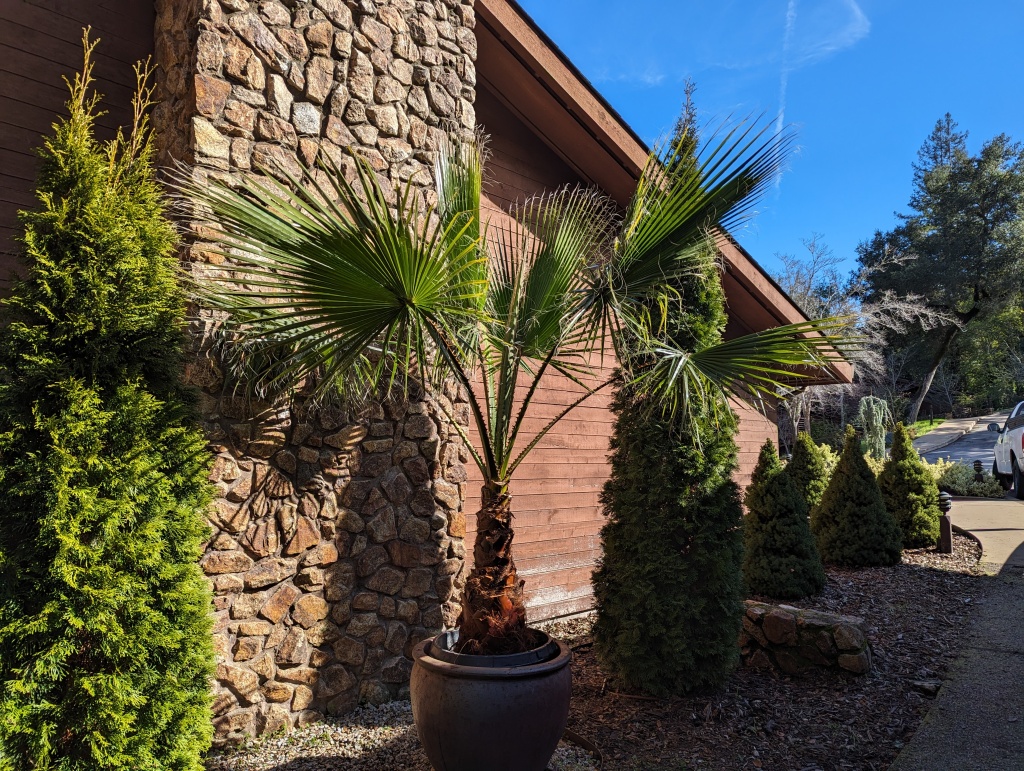
2. Wicked spines on its petioles contribute to the difficulty of relocating this heavy palm.
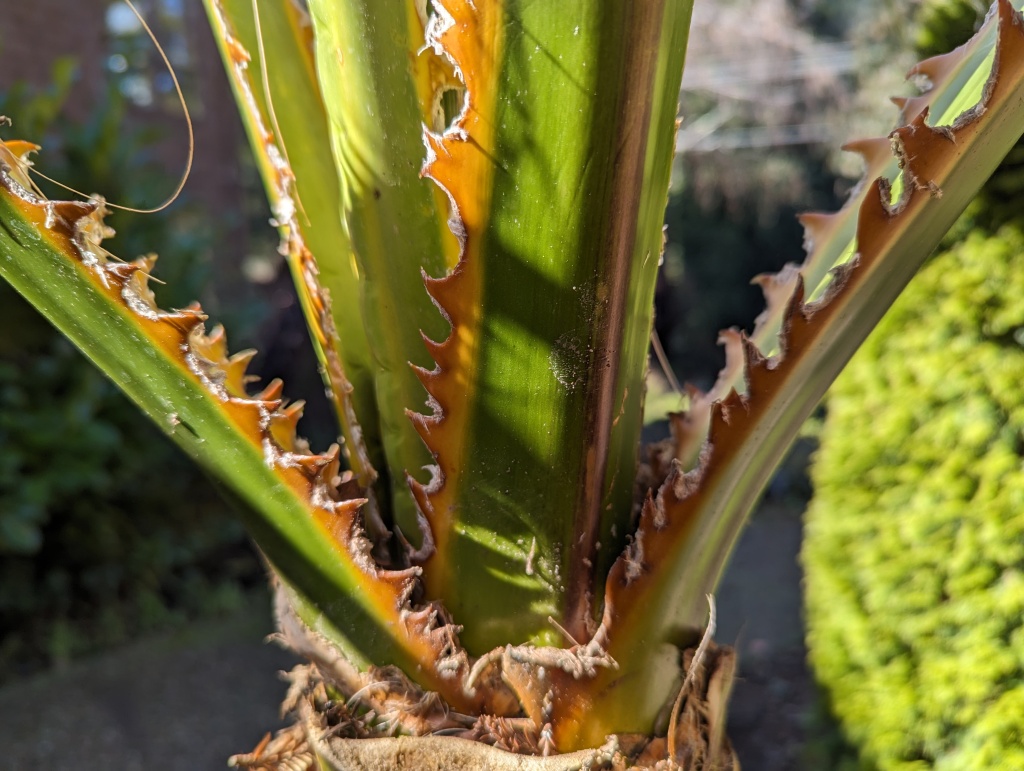
3. Trachycarpus fortunei, windmill palm is also too pretty to stay unseen in the nursery. It will also get groomed and relocated temporarily to a landscape next week. This young palm grew in the garden of the mother of childhood friends, so I am very protective of it.
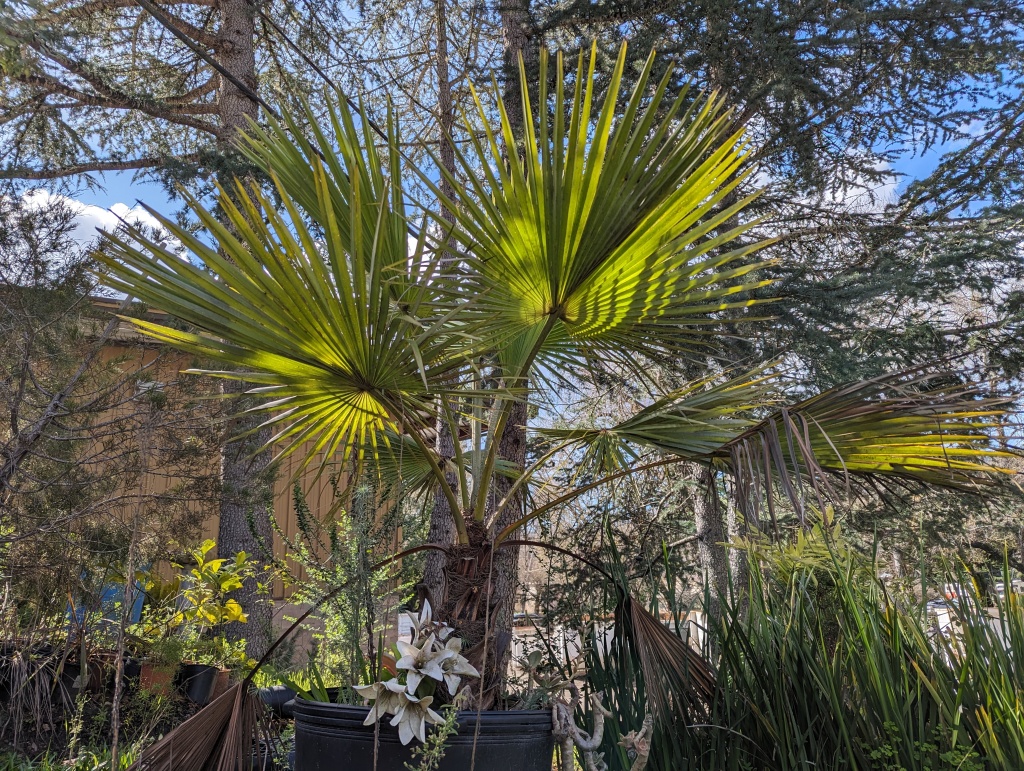
4. Palms and redwoods do not mix well. A colleague wants this windmill palm gone. It is about twenty four feet tall. That ladder is eight feet tall. It will be difficult to relocate, but I do not want it cut down and killed. Like the others, I have no idea of what to do with it.
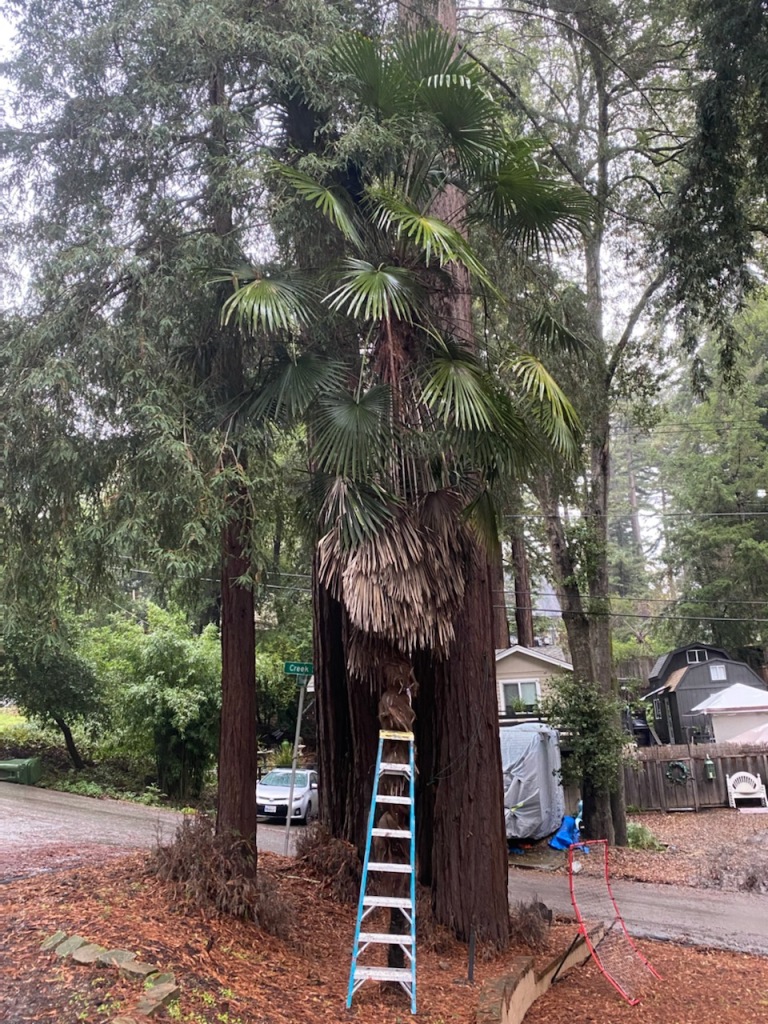
5. Brent’s curbside Mexican fan palm looks embarrassed with its silly uplighting. That is the moon above. This palm, which is a Memorial Tree for Brent’s brother, was about ten feet tall when relocated here because it grew under electrical cables several blocks away.
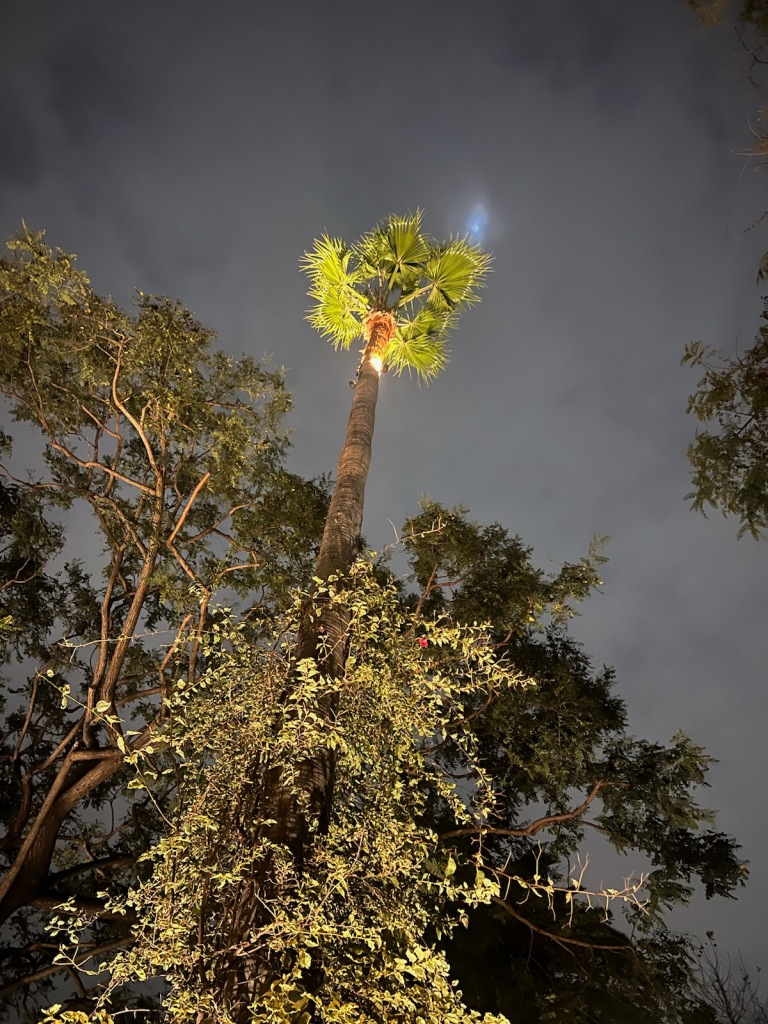
6. Bedford Drive, nearer to the original location of Brent’s curbside Mexican fan palm, is flanked by very old and alternating Mexican fan palms and Phoenix canariensis, Canary Island date palms. They were grandly uniform until the Canary Island date palms began to succumb to pink rot during the 1980s. The Beverly Hillbillies started their shows with a scene of their arrival in town on a similarly flanked street three blocks to the northeast.
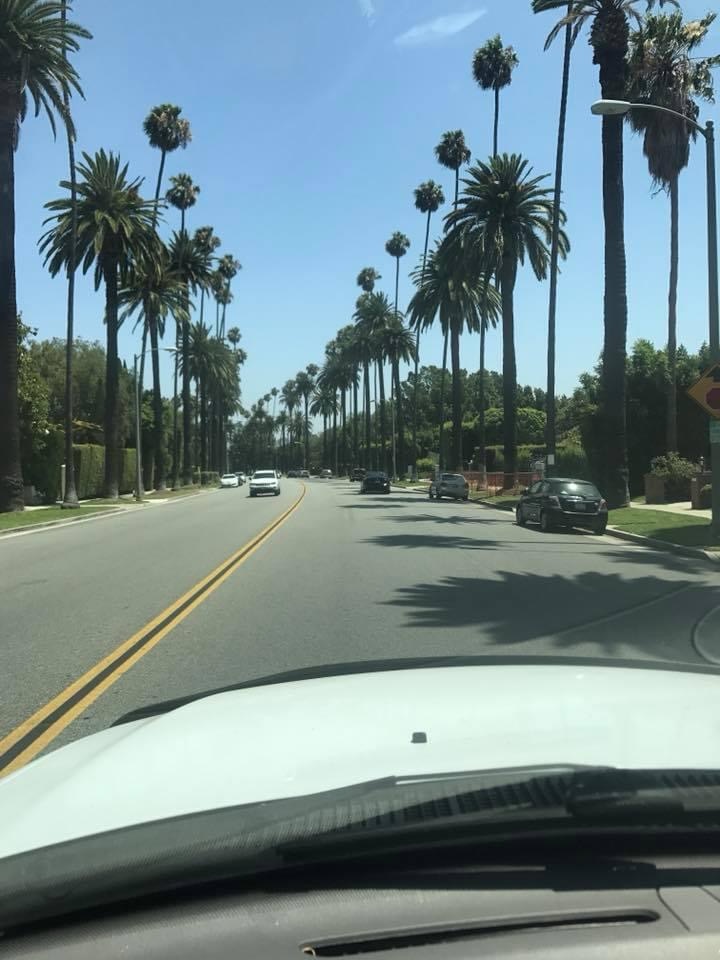
This is the link for Six on Saturday, for anyone else who would like to participate: https://thepropagatorblog.wordpress.com/2017/09/18/six-on-saturday-a-participant-guide/
We used to love the Beverley Hill Billies when we were kids, although I don’t remember noticing any palms then. If I see a rerun (although those were reruns already) I will make sure I look. Lovely palm-fest, I especially love Brent’s with his dramatic lighting. 🙂
LikeLiked by 1 person
At the beginning of the show, when the actors are introduced, the family is driving their old Oldsmobile on one of the palm flanked streets. We always believe that it was on Bedford Drive, but it was supposedly on North Beverly Drive. I suppose that I could identify it if I wanted to analyze the video. The Canary Island date palms started to succumb to pink rot in the 1980s because of the ‘pineapple cut’ pruning style that was trendy at the time, and because the trees are elderly and more susceptible to such disease. It is a slow process, and after all these decades, most of the old trees remain. Of course, they are not pruned so severely now. They were probably at their best after the Beverly Hillbillies, when they had that long-haired hippie look.
LikeLiked by 1 person
Maybe one day I’ll get to visit. Nothing is impossible!
LikeLiked by 1 person
There are more interesting places to visit.
LikeLike
I love the photo with the Mexican fan palm lit up… I also have a washingtonia in a pot (filifera or Robusta, the difference is not easy to find… it comes from seeds brought from Egypt) and a Trachy in the ground for years.
LikeLiked by 1 person
Washingtonia filifera is supposedly easy to distinguish from Washingtonia robusta, but a small specimen that I grew on my patio in town many years ago really did look like a Washingtonia robusta while young. The primary differences that you should notice, although I never did, is the abundance of foliar filaments at the tips of the leaves, the less wicked petiole spines, and the lighter brown stripes under the petioles. Washingtonia robusta has less foliar filaments, nastier petiole thorns, and a more prominent brown stripe under its petioles. As the mature, Washingtonia robusta has more rigid foliage, and Washingtonia filifera has more pliable foliage on slightly flatter petioles that fold back more gently. Of course, these differences are not easy to qualify without comparison. Nowadays, some classify Washingtonia filifera as a variety of Washingtonia robusta. Washingtonia filifera is my favorite of all palms, but unfortunately, is not as adaptable to landscapes. It prefers warm and arid summer weather, and dislikes humidity and too much irrigation within dense or rich soils. In the wild, it inhabits riparian situations, but the soil in such situations is gravely. It really is a spectacular species in wild oases around Palm Springs.
LikeLiked by 1 person
thank you for your description and all the differences between the 2 varieties. I will probably post a photo of my youn one in the spring in a Six on Saturday. And like that you will give me your opinion between the 2 varieties robusta and filifera.
LikeLiked by 1 person
Yes; it would help to get pictures of the undersides of the petioles near their bases, which should also show the petiole teeth, as well as the tips of the leaves.
LikeLiked by 1 person
I potted up a few tiny Trachycarpus fortunei seedlings a year or two back. Pure sentiment, I have no use for them and they are probably much slower here than with you, so I can see me keeping them in pots for years then giving them away.
LikeLiked by 1 person
The growth rate of palms is remarkably variable, and it seems that windmill palms are the most variable. (Although, among established trees in the ground, queen palms are more variable.) They can grow quite fast in most situations with warmth and water, but mine has been potted for several years, and is in no hurry to leave the large pot. The cool thing about palms is that once they launch, they need no more soil volume when twenty feet from the ground than they did when they were one foot from the ground. Their canopies grow no larger, only higher.
LikeLike
Love the palms. I have a free range W.robusta here. It just hangs out and acts as a shrub.
LikeLiked by 1 person
That is not one that I would expect to be common there. I have seen it is pictures of your region, but I notice more of the palms that we do not grow here.
LikeLiked by 1 person
Actually there are a lot of them here. Popular in shopping centers, etc
LikeLiked by 1 person